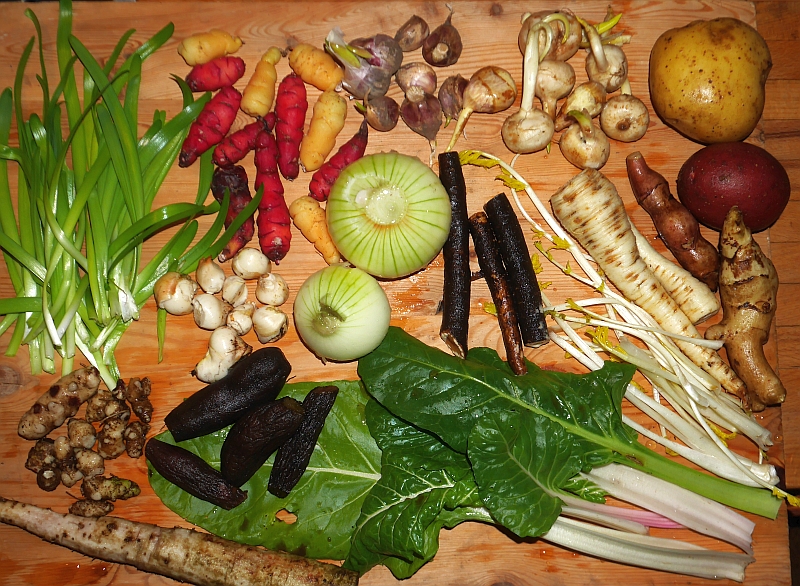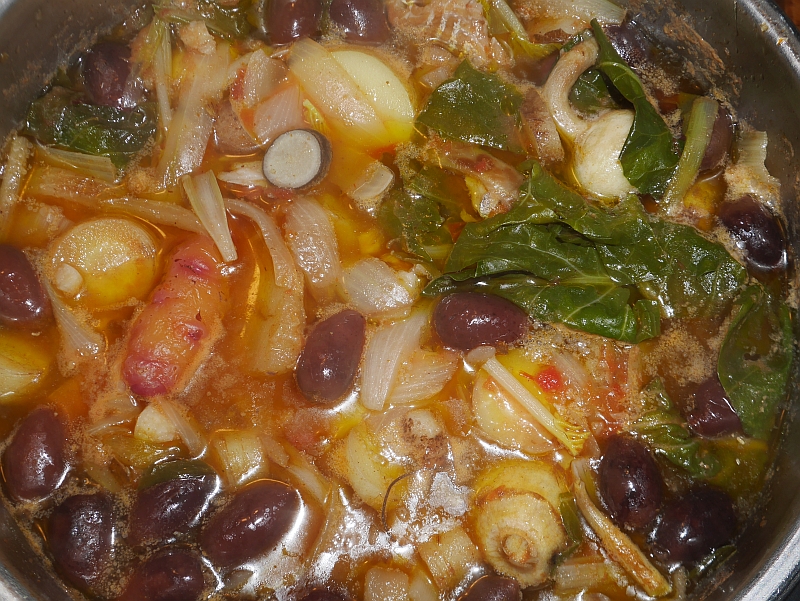We occasionally eat wild fish and bacalhau is a favourite made from Norwegian dried cod that can be found in supermarkets here. More or less anything goes in bacalhau (bacalao) and although most people make it in the same way – layers of potato, fish, tomato and onions, often with chili – the Portuguese have hundreds of ways of preparing baccalao (dried cod). Being self-sufficient, detailed recipes aren¨’t useful and we use whatever is available at the moment. Winter is the time for stored bulbs, corms, tubers, rhizomes, and taproots. See below the picture for yesterday’s baccalao ingredients with 14 home grown below surface storage organs plus some greens (I’m pretty sure nobody else had this version of the dish…ever!):
Oca (Oxalis tuberosa): yellow and red varieties
Garlic / hvitløk (Allium sativum)
Wapato (Sagittaria latifolia)
Potato / potet (Solanum tuberosum) – 2 varieties
Jerusalem artichokes / jordskokk (Helianthus tuberosus)
Parsnip / pastinakk (Pastinaca sativa)
Scorzonera / scorsonerrot (Scorzonera hispanica)
Common onion / kepaløk (Allium cepa)
Cacomitl (Tigridia pavonia)
Yacon (Polymnia sonchifolia)
Burdock / storborre (Arctium lappa)
Madeira vine (Anredera cordifolia)
Parsnip / pastinakk (Pastinaca sativa) shoots – had started shooting in the cellar
Leaf beets / bladbete (Beta vulgaris var. flavescens) – 3 varieties
Allium nutans (forced in the living room)
plus (not home grown) organic tomatoes, olive oil and olives
(I forgot the dandelion…will add tonight: we make enough that it lasts for several days….and the taste improves!)

Thanks a lot for this very informative and beautiful website
on edible perennials. In the last three years, your book had
a big influence on how I garden (and eat!). I have a couple
of question regarding forcing. Do you water the roots in the
cellar during the period from transplanting to the final
harvest, or do you water only when they start sprouting?
After the roots have sprouted, do you discard them in the
compost bin, or do you plant them back in the garden in
order to regenerate them (and perhaps collect them again in
the next autumn)?
Serge.
Thanks for your kind words!
My cellar has a constant temperature from 2-6C during the winter. For some plants like chicories and dandelions, they grow well and I harvest the shoots from the cellar directly. Those plants aren’t watered at all. I also bring pots upstairs and force them for an earlier harvest in much warmer temperatures. I usually give those pots some water. Dandelions usually end up as compost, but chicories, for example, are sometimes planted back in the garden to produce seed or just because they are valuable for pollinating insects. Perennial plants may be planted back in the garden after harvest. Some perennial onions are just left in their pots to be forced again the following winter
Best wishes, Stephen